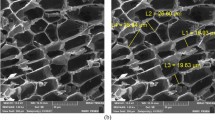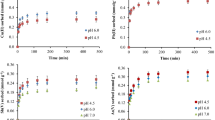Abstract
Biomass-derived biochar is considered as a promising heavy metal adsorbent, due to abundance of polar functional groups, such as carboxylic, hydroxyl, and amino groups, which are available for heavy metal removal. The aims of this study were to evaluate the effectiveness of an orchard pruning-derived biochar in removing some heavy metals (through the evaluation of isotherms) and to study water dynamics at the solid-liquid interface as affected by heavy metal adsorption (through an innovative nuclear magnetic resonance (NMR) relaxometry approach). Both isotherms and NMR spectra revealed that Pb and Cr showed a good affinity for the biochar surface (Pb > Cr), while Cu was less affine. Accordingly, higher amounts of Pb and Cr were adsorbed by biochar as compared to those of Cu in the single systems. In binary systems (i.e., when two metals were applied simultaneously), Pb showed the highest inhibition of the adsorption of the other two metals, whereas the opposite was evidenced when Cu was used; the competitive adsorption was also strongly influenced by the metal residence time on biochar surface. In ternary systems (i.e., when all metals were applied simultaneously), even in the presence of high amounts of Pb and Cr, considerable adsorption of Cu occurred, indicating that some biochar adsorption sites were highly specific for a single metal.








Similar content being viewed by others
References
Baronti S, Vaccari FP, Miglietta F, Calzolari C, Lugato E, Orlandini S, Pini R, Zulian C, Genesio L (2014) Impact of biochar application on plant water relations in Vitis vinifera (L.). Eur J Agron 53:38–44. doi:10.1016/j.eja.2013.11.003
Beesley L, Marmiroli M (2011) The immobilisation and retention of soluble arsenic, cadmium and zinc by biochar. Environ Pollut 159:474–480. doi:10.1016/j.envpol.2010.10.016
Cao XD, Ma LN, Gao B, Harris W (2009) Dairy-manure derived biochar effectively sorbs lead and atrazine. Environ Sci Technol 43:3285–3291. doi:10.1021/Es803092k
Castaldi S, Riondino M, Baronti S, Esposito FR, Marzaioli R, Rutigliano FA, Vaccari FP, Miglietta F (2011) Impact of biochar application to a Mediterranean wheat crop on soil microbial activity and greenhouse gas fluxes. Chemosphere 85:1464–1471. doi:10.1016/j.chemosphere.2011.08.031
Chen XC, Chen GC, Chen LG, Chen YX, Lehmann J, McBride MB, Hay AG (2011) Adsorption of copper and zinc by biochars produced from pyrolysis of hardwood and corn straw in aqueous solution. Bioresour Technol 102:8877–8884. doi:10.1016/j.biortech.2011.06.078
Cimò G, Kucerik J, Berns AE, Schaumann GE, Alonzo G, Conte P (2014) Effect of heating time and temperature on the chemical characteristics of biochar from poultry manure. J Agric Food Chem 62:1912–1918. doi:10.1021/Jf405549z
Conte P, Alonzo G (2013) Environmental NMR: fast-field-cycling relaxometry. eMagRes 2:389–398. doi:10.1002/9780470034590.emrstm1330
Conte P, Marsala V, De Pasquale C, Bubici S, Valagussa M, Pozzi A, Alonzo G (2013) Nature of water-biochar interface interactions. GCB Bioenergy 5:116–121. doi:10.1111/Gcbb.12009
Conte P, Hanke UM, Marsala V, Cimò G, Alonzo G, Glaser B (2014) Mechanisms of water interaction with pore systems of hydrochar and pyrochar from poplar forestry waste. J Agric Food Chem 62:4917–4923. doi:10.1021/Jf5010034
De Pasquale C, Marsala V, Berns AE, Valagussa M, Pozzi A, Alonzo G, Conte P (2012) Fast field cycling NMR relaxometry characterization of biochars obtained from an industrial thermochemical process. J Soils Sediments 12:1211–1221. doi:10.1007/s11368-012-0489-x
Demirbas E, Kobya M, Senturk E, Ozkan T (2004) Adsorption kinetics for the removal of chromium (VI) from aqueous solutions on the activated carbons prepared from agricultural wastes. Water SA 30:533–539
Dong XL, Ma LNQ, Li YC (2011) Characteristics and mechanisms of hexavalent chromium removal by biochar from sugar beet tailing. J Hazard Mater 190:909–915. doi:10.1016/j.jhazmat.2011.04.008
Farrell M, Macdonald LM, Butler G, Chirino-Valle I, Condron LM (2014) Biochar and fertiliser applications influence phosphorus fractionation and wheat yield. Biol Fertil Soils 50:169–178. doi:10.1007/s00374-013-0845-z
Fellet G, Marchiol L, Delle Vedove G, Peressotti A (2011) Application of biochar on mine tailings: effects and perspectives for land reclamation. Chemosphere 83:1262–1267. doi:10.1016/j.chemosphere.2011.03.053
Hsu NH, Wang SL, Lin YC, Sheng GD, Lee JF (2009) Reduction of Cr(VI) by crop-residue-derived black carbon. Environ Sci Technol 43:8801–8806. doi:10.1021/Es901872x
Inyang M, Gao B, Yao Y, Xue YW, Zimmerman AR, Pullammanappallil P, Cao XD (2012) Removal of heavy metals from aqueous solution by biochars derived from anaerobically digested biomass. Bioresour Technol 110:50–56. doi:10.1016/j.biortech.2012.01.072
Jiang J, Xu RK, Jiang TY, Li Z (2012a) Immobilization of Cu(II), Pb(II) and Cd(II) by the addition of rice straw derived biochar to a simulated polluted Ultisol. J Hazard Mater 229:145–150. doi:10.1016/j.jhazmat.2012.05.086
Jiang TY, Jiang J, Xu RK, Li Z (2012b) Adsorption of Pb(II) on variable charge soils amended with rice-straw derived biochar. Chemosphere 89:249–256. doi:10.1016/j.chemosphere.2012.04.028
Kammann CI, Linsel S, Gossling JW, Koyro HW (2011) Influence of biochar on drought tolerance of Chenopodium quinoa Willd and on soil-plant relations. Plant Soil 345:195–210. doi:10.1007/s11104-011-0771-5
Laird DA (2008) The charcoal vision: a win-win-win scenario for simultaneously producing bioenergy, permanently sequestering carbon, while improving soil and water quality. Agron J 100:178–181. doi:10.2134/agronj2007.0161
Laird D, Fleming P, Wang BQ, Horton R, Karlen D (2010) Biochar impact on nutrient leaching from a Midwestern agricultural soil. Geoderma 158:436–442. doi:10.1016/j.geoderma.2010.05.012
Lehmann J (2007a) Bio-energy in the black. Front Ecol Environ 5:381–387. doi:10.1890/1540-9295(2007)5[381:Bitb]2.0.Co;2
Lehmann J (2007b) A handful of carbon. Nature 447:143–144. doi:10.1038/447143a
Lehmann J, Skjemstad J, Sohi S, Carter J, Barson M, Falloon P, Coleman K, Woodbury P, Krull E (2008) Australian climate-carbon cycle feedback reduced by soil black carbon. Nat Geosci 1:832–835. doi:10.1038/Ngeo358
Li M, Liu Q, Guo LJ, Zhang YP, Lou ZJ, Wang Y, Qian GR (2013) Cu(II) removal from aqueous solution by Spartina alterniflora derived biochar. Bioresour Technol 141:83–88. doi:10.1016/j.biortech.2012.12.096
Liu ZG, Zhang FS (2009) Removal of lead from water using biochars prepared from hydrothermal liquefaction of biomass. J Hazard Mater 167:933–939. doi:10.1016/j.jhazmat.2009.01.085
Lu HL, Zhang WH, Yang YX, Huang XF, Wang SZ, Qiu RL (2012) Relative distribution of Pb2+ sorption mechanisms by sludge-derived biochar. Water Res 46:854–862. doi:10.1016/j.watres.2011.11.058
Major J, Rondon M, Molina D, Riha SJ, Lehmann J (2010) Maize yield and nutrition during 4 years after biochar application to a Colombian savanna oxisol. Plant Soil 333:117–128. doi:10.1007/s11104-010-0327-0
Mohan D, Pittman CU, Bricka M, Smith F, Yancey B, Mohammad J, Steele PH, Alexandre-Franco MF, Gomez-Serrano V, Gong H (2007) Sorption of arsenic, cadmium, and lead by chars produced from fast pyrolysis of wood and bark during bio-oil production. J Colloid Interface Sci 310:57–73. doi:10.1016/j.jcis.2007.01.020
Mohan D, Rajput S, Singh VK, Steele PH, Pittman CU (2011) Modeling and evaluation of chromium remediation from water using low cost bio-char, a green adsorbent. J Hazard Mater 188:319–333. doi:10.1016/j.jhazmat.2011.01.127
Prayogo C, Jones JE, Baeyens J, Bending GD (2014) Impact of biochar on mineralisation of C and N from soil and willow litter and its relationship with microbial community biomass and structure. Biol Fertil Soils 50:695–702. doi:10.1007/s00374-013-0884-5
Qiu YP, Cheng HY, Xu C, Sheng D (2008) Surface characteristics of crop-residue-derived black carbon and lead(II) adsorption. Water Res 42:567–574. doi:10.1016/j.watres.2007.07.051
Regmi P, Moscoso JLG, Kumar S, Cao XY, Mao JD, Schafran G (2012) Removal of copper and cadmium from aqueous solution using switchgrass biochar produced via hydrothermal carbonization process. J Environ Manag 109:61–69. doi:10.1016/j.jenvman.2012.04.047
Shen YS, Wang SL, Tzou YM, Yan YY, Kuan WH (2012) Removal of hexavalent Cr by coconut coir and derived chars—the effect of surface functionality. Bioresour Technol 104:165–172. doi:10.1016/j.biortech.2011.10.096
Shi TH, Jia SG, Chen Y, Wen YH, Du CM, Guo HL, Wang ZC (2009) Adsorption of Pb(II), Cr(III), Cu(II), Cd(II) and Ni(II) onto a vanadium mine tailing from aqueous solution. J Hazard Mater 169:838–846. doi:10.1016/j.jhazmat.2009.04.020
Song YJ, Zhang XL, Ma B, Chang SX, Gong J (2014) Biochar addition affected the dynamics of ammonia oxidizers and nitrification in microcosms of a coastal alkaline soil. Biol Fertil Soils 50:321–332. doi:10.1007/s00374-013-0857-8
Sparks DL (2002) Environmental soil chemistry. Academic Press, New York
Srivastava NK, Majumder CB (2008) Novel biofiltration methods for the treatment of heavy metals from industrial wastewater. J Hazard Mater 151:1–8. doi:10.1016/j.jhazmat.2007.09.101
Stewart CE, Zheng JY, Botte J, Cotrufo MF (2013) Co-generated fast pyrolysis biochar mitigates green-house gas emissions and increases carbon sequestration in temperate soils. GCB Bioenergy 5:153–164. doi:10.1111/Gcbb.12001
Tong XJ, Li JY, Yuan JH, Xu RK (2011) Adsorption of Cu(II) by biochars generated from three crop straws. Chem Eng J 172:828–834. doi:10.1016/j.cej.2011.06.069
Uchimiya M, Lima IM, Klasson KT, Chang SC, Wartelle LH, Rodgers JE (2010) Immobilization of heavy metal ions (Cu-II, Cd-II, Ni-II, and Pb-II) by broiler litter-derived biochars in water and soil. J Agric Food Chem 58:5538–5544. doi:10.1021/Jf9044217
Uchimiya M, Chang S, Klasson KT (2011) Screening biochars for heavy metal retention in soil: role of oxygen functional groups. J Hazard Mater 190:432–441. doi:10.1016/j.jhazmat.2011.03.063
Vaccari FP, Baronti S, Lugato E, Genesio L, Castaldi S, Fornasier F, Miglietta F (2011) Biochar as a strategy to sequester carbon and increase yield in durum wheat. Eur J Agron 34:231–238. doi:10.1016/j.eja.2011.01.006
Wang XS, Chen LF, Li FY, Chen KL, Wan WY, Tang YJ (2010) Removal of Cr (VI) with wheat-residue derived black carbon: reaction mechanism and adsorption performance. J Hazard Mater 175:816–822. doi:10.1016/j.jhazmat.2009.10.082
Xu XY, Cao XD, Zhao L, Wang HL, Yu HR, Gao B (2013) Removal of Cu, Zn, and Cd from aqueous solutions by the dairy manure-derived biochar. Environ Sci Pollut Res 20:358–368. doi:10.1007/s11356-012-0873-5
Zhang WH, Mao SY, Chen H, Huang L, Qiu RL (2013) Pb(II) and Cr(VI) sorption by biochars pyrolyzed from the municipal wastewater sludge under different heating conditions. Bioresour Technol 147:545–552. doi:10.1016/j.biortech.2013.08.082
Zhu J, Pigna M, Cozzolino V, Caporale AG, Violante A (2010) Competitive sorption of copper(II), chromium(III) and lead(II) on ferrihydrite and two organomineral complexes. Geoderma 159:409–416. doi:10.1016/j.geoderma.2010.09.006
Acknowledgments
The authors wish to acknowledge the Institute of Biometeorology (IBIMET), National Research Council (CNR) of Florence, Italy, and, in particular, Dr. Silvia Baronti, who kindly offered the biochar applied in the present study. This work was supported by the Italian Research Program of National Interest (PRIN 2010–2011).
Author information
Authors and Affiliations
Corresponding author
Rights and permissions
About this article
Cite this article
Caporale, A.G., Pigna, M., Sommella, A. et al. Effect of pruning-derived biochar on heavy metals removal and water dynamics. Biol Fertil Soils 50, 1211–1222 (2014). https://doi.org/10.1007/s00374-014-0960-5
Received:
Revised:
Accepted:
Published:
Issue Date:
DOI: https://doi.org/10.1007/s00374-014-0960-5




